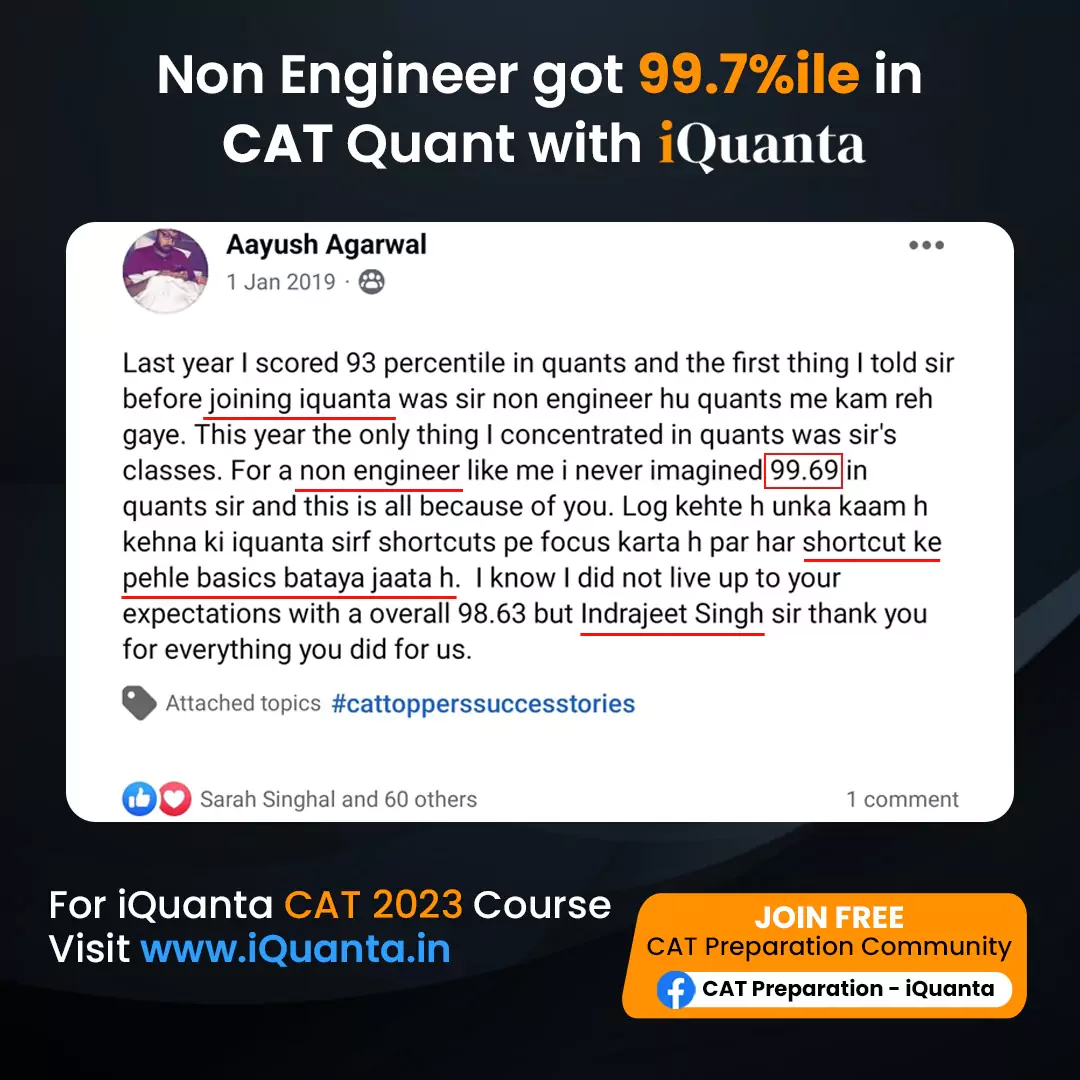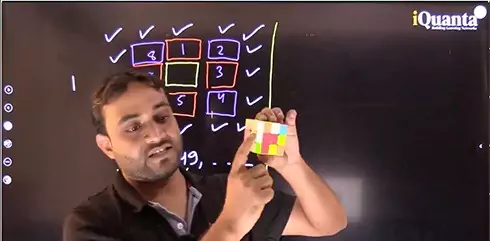Your Guides
CAT 2025 Start Early Batch...
 Non Engineers QUANT Videos
Non Engineers QUANT Videos  Engineers VARC Videos
Engineers VARC Videos
 24/7 Doubts Soving
24/7 Doubts Soving  AI Based Mock Series
AI Based Mock Series
iQuanta's CAT 2025 program assists students with targeted preparation across every key area of the exam. Build a rock-solid foundation of core-concepts, master time-saving strategies and learn how to calm exam-day nerves.
This Year NEW ADDONs
Engineers' VARC, Non-Engineers’ Quant Conceptual Videos,LRDI Essential & Inception Modules
Quant
300+ Hours of Live Interactive Sessions
700+ videos (Conceptual + Problem Solving videos)
70+ Assignments (with varying Difficulty)
LRDI
200+ Hours of Live Interactive Sessions
250+ videos
30+ Assignments
VARC
200+ Hours of Live Interactive Sessions
250+ videos
30+ Assignments
Dual Pedagogy Teaching Both Conceptual Live Stream as well as Live Application Sessions.
A combination of well-explained shortcuts & concepts.
Practice
1500+ QA
300+ LRDI Sets
700+ VARC Questions
Mocks
35 Full Mocks
45 Sectionals (15 each for all three sections)
15 Non-CAT Mock (XAT, IIFT, SNAP, NMAT)
Mocks (Bonus): Video Solutions For all the questions in Full Mocks & Sectionals
Crash Course:
60+ Sessions of QA+LRDI+VARC Inclusive of shortcuts and Past CAT Practice
(Crash Course Worth Rs 15,000 Free Only For Full Course Students)
Speciality :
24x7 doubt clarification from any material and not just iQuanta's.
Highly Relevant set of 250 iQuanta Questions in last 2 months.
You will get access to 100+ Conceptual videos as soon as you enroll.
Live Class Timing:
7 PM to 9 PM (4 days a week)
Application Classes From April 10 PM to 12 AM | 6 days a week
2 days Quant, 2 Days Verbal, 2 Days LRDI.
So, a total 20 hours of classes every week
If you miss a class, you can go through it at any point in time.
This Year NEW ADDONs
Engineers' VARC: How to Crack CAT VARC, the Engineer's way.
70 videos on concepts and strategy
10 Videos on strategy for every topic
40 Videos on RC ( Total 8 Genres, 5 RC in each )
20 Videos on VA (PJ, PS, OOO etc.)
Non-Engineers’ Conceptual Videos for those extremely weak in Quants.
70 Videos (35+ Hrs of Recording)
LRDI Inception - Top Notch CAT Level Sets with Detailed video solution by Faculties
Quant
300+ Hours of Live Interactive Sessions
700+ videos (Conceptual + Problem Solving videos)
70+ Assignments (with varying Difficulty)
LRDI
200+ Hours of Live Interactive Sessions
250+ videos
30+ Assignments
VARC
200+ Hours of Live Interactive Sessions
250+ videos
30+ Assignments
Dual Pedagogy Teaching Both Conceptual Live Stream as well as Live Application Sessions.
A combination of well-explained shortcuts & concepts.
Practice
1500+ QA
300+ LRDI Sets
700+ VARC Questions
Mocks
35 Full Mocks
45 Sectionals (15 each for all three sections)
15 Non-CAT Mock (XAT, IIFT, SNAP, NMAT)
Mocks (Bonus): Video Solutions For all the questions in Full Mocks & Sectionals
Crash Course:
60+ Sessions of QA+LRDI+VARC Inclusive of shortcuts and Past CAT Practice
(Crash Course Worth Rs 15,000 Free Only For Full Course Students)
Specialty:
24x7 doubt clarification from any material and not just iQuanta's.
Highly Relevant set of 250 iQuanta Questions in last 2 months.
You will get access to 100+ Conceptual videos as soon as you enroll.
Live Class Timing:
7 PM to 9 PM Onwards it (4 days a week)
Application Classes From April 10 PM to 12 AM | 6 days a week
2 days Quant, 2 Days Verbal, 2 Days LRDI.
So, a total 20 hours of classes every week from April
If you miss a class, you can go through it at any point in time.
This Year NEW ADDONs
Engineers VARC : How to Crack CAT VARC, the Engineer's way. 70 videos on concepts and strategy
10 Videos on strategy for every topic
40 Videos on RC ( Total 8 Genres, 5 RC in each )
20 Videos on VA (PJ, PS, OOO etc.)
Non-Engineers’ Conceptual Videos for those extremely weak in Quants.
70 Videos (35+ Hrs of Recording)
LRDI Inception- Top Notch CAT Level Sets with Detailed video solution by Faculties
Quant
300+ Hours of Live Interactive Sessions
700+ videos (Conceptual + Problem Solving videos)
70+ Assignments (with varying Difficulty)
LRDI
200+ Hours of Live Interactive Sessions
250+ videos
30+ Assignments
VARC
200+ Hours of Live Interactive Sessions
250+ videos
30+ Assignments
Dual Pedagogy Teaching Both Conceptual Live Stream as well as Live Application Sessions.
A combination of well-explained shortcuts & concepts.
Practice
1500+ QA
300+ LRDI Sets
700+ VARC Questions
Mocks
35 Full Mocks
45 Sectionals (15 each for all three sections)
15 Non-CAT Mock (XAT, IIFT, SNAP, NMAT)
Mocks (Bonus): Video Solutions For all the questions in Full Mocks & Sectionals
Crash Course:
60+ Sessions of QA+LRDI+VARC Inclusive of shortcuts and Past CAT Practice
(Crash Course Worth Rs 15,000 Free Only For Full Course Students)
Specialty:
24x7 doubt clarification from any material and not just iQuanta's.
Highly Relevant set of 250 iQuanta Questions in last 2 months.
You will get access to 100+ Conceptual videos as soon as you enroll.
Live Class Timing:
5 PM to 7 PM till December (2 days a week), 7 PM to 9 PM Onwards it (3-4 days a week)
Application Classes From February 10 PM to 12 AM | 6 days a week
2 days Quant, 2 Days Verbal, 2 Days LRDI.
So, a total 20 hours of classes every week from February
If you miss a class, you can go through it at any point in time.
This Year NEW ADDONs
Engineers' VARC : How to Crack CAT VARC, the Engineer's way.
70 videos on concepts and strategy
10 Videos on strategy for every topic
40 Videos on RC ( Total 8 Genres, 5 RC in each )
20 Videos on VA (PJ, PS, OOO etc.)
Non-Engineers’ Conceptual Videos for those extremely weak in Quants.
70 Videos (35+ Hrs of Recording)
LRDI Inception - Top Notch CAT Level Sets with Detailed video solution by Faculties
Quant
300+ Hours of Live Interactive Sessions
700+ videos (Conceptual + Problem Solving videos)
70+ Assignments (with varying Difficulty)
LRDI
200+ Hours of Live Interactive Sessions
250+ videos
30+ Assignments
VARC
200+ Hours of Live Interactive Sessions
250+ videos
30+ Assignments
Dual Pedagogy Teaching Both Conceptual Live Stream as well as Live Application Sessions.
A combination of well-explained shortcuts & concepts.
Practice
1500+ QA
300+ LRDI Sets
700+ VARC Questions
Mocks
35 Full Mocks
45 Sectionals (15 each for all three sections)
15 Non-CAT Mock (XAT, IIFT, SNAP, NMAT)
Mocks (Bonus): Video Solutions For all the questions in Full Mocks & Sectionals
Crash Course:
60+ Sessions of QA+LRDI+VARC Inclusive of shortcuts and Past CAT Practice
(Crash Course Worth Rs 15,000 Free Only For Full Course Students)
Specialty:
24x7 doubt clarification from any material and not just iQuanta's.
Highly Relevant set of 250 iQuanta Questions in last 2 months.
You will get access to 100+ Conceptual videos as soon as you enroll.
Live Class Timing:
5 PM to 7 PM till December (2 days a week), 7 PM to 9 PM Onwards it (3-4 days a week)
Application Classes From February 10 PM to 12 AM | 6 days a week
2 days Quant, 2 Days Verbal, 2 Days LRDI.
So, a total 20 hours of classes every week from February
If you miss a class, you can go through it at any point in time.
This is the Flagship combo course of iQuanta and includes everything provided in CAT | XAT | IIFT | MICAT | NMAT-SNAP | CMAT Course.
Course allotment timeline will be provided in DASHBOARD.
iCAT Mocks
35 Full CAT MOCKS
45 Sectional CAT MOCKS
Excellent Mock Analysis
All the Questions in Full CAT Mocks have detailed video solutions.
AI Based Mock Analysis with Error Tracker
Set your Target on the basis of your preferred B-School
Analysis Across all Mocks
Goal Tracker with Suggested Measures to improve
IIM ABC Practice Batch
500 RCs
500 LRDI Sets
2500 QA
3500 Questions in dashboard & Remaining 3500 Questions will be given daily as
12 Quant
3 RC Sets
3 LRDI Sets
CAT Books
12 Sets of CAT Material updated as per CAT 2024 Standards
5000+ Questions Topic wise as well as Level wise
Quant
5 Sets of Materials: 2350 Questions
Geometry: 350 + 100 Author’s Desk Questions
Modern Maths, Logs, Functions & Graphs : 250 + 100 Author’s Desk Questions
Number System : 250. + 100 Author’s Desk Question
Algebra : 350 + 150 Author’s Desk Questions
Arithmetic : 550 + 150 Author’s Desk Questions
-Each Topic has bifurcated sub topics having 50 Questions each 30 Easy-Moderate and 20 Moderate to Tough
-100 Author’s Desk Questions specially curated by Indra for each Topic
VARC
3 Sets of Materials : 240 RC Sets + 200 VA : 1160 Questions
CAT VA - 1 book
4 topics - Parajumbles, Odd one out, Parasummary, Paracompletion
50 questions each.
CAT RC - 2 books
RC Book 1 : 120 RC Sets from 8 Genre
RC book 2 : 120 RC Sets from 8 mixed Genre
LRDI
4 Sets of Materials :
4 books: 2 LR & 2 DI: 440 LRDI Sets: 1760 Questions
Both LR books having 160 LRDI Sets
Both DI books having 120 LRDI Sets
Gift
160 LRDI Sets & Puzzles of exact CAT 23 Level sets
12 Sets of CAT Material updated as per CAT 2024 Standards
5000+ Questions Topic wise as well as Level wise
Quant
5 Sets of Materials: 2350 Questions
Geometry: 350 + 100 Author’s Desk Questions
Modern Maths, Logs, Functions & Graphs : 250 + 100 Author’s Desk Questions
Number System : 250. + 100 Author’s Desk Question
Algebra : 350 + 150 Author’s Desk Questions
Arithmetic : 550 + 150 Author’s Desk Questions
-Each Topic has bifurcated sub topics having 50 Questions each 30 Easy-Moderate and 20 Moderate to Tough
-100 Author’s Desk Questions specially curated by Indra for each Topic
VARC
3 Sets of Materials : 240 RC Sets + 200 VA : 1160 Questions
CAT VA - 1 book
4 topics - Parajumbles, Odd one out, Parasummary, Paracompletion
50 questions each.
CAT RC - 2 books
RC Book 1 : 120 RC Sets from 8 Genre
RC book 2 : 120 RC Sets from 8 mixed Genre
LRDI
4 Sets of Materials :
4 books: 2 LR & 2 DI: 440 LRDI Sets: 1760 Questions
Both LR books having 160 LRDI Sets
Both DI books having 120 LRDI Sets
Gift
160 LRDI Sets & Puzzles of exact CAT 23 Level sets
CAT MOCKS
35 Full CAT MOCKS
-20 CAT Full length Proctored Mocks with video solution
-15 CAT Full length Un proctored Mocks with video solution
-45 Sectional CAT MOCKS with video solution
Excellent Mock Analysis
All the Questions in Full CAT Mocks have detailed video solutions.
AI Based Mock Analysis with Error Tracker
Set your Target on the basis of your preferred B-School
Analysis Across all Mocks
Goal Tracker with Suggested Measures to improve
The level of our iQuanta Mocks were of exact same level as that of CAT 2018,2019,2020, 2021,2022 & 2023, 2024 be it Quant , LRDI, or VARC
CAT BOOKS
12 Sets of CAT Material updated as per CAT 2024 Standards
5000+ Questions Topic wise as well as Level wise
Quant
5 Sets of Materials: 2350 Questions
Geometry: 350 + 100 Author’s Desk Questions
Modern Maths, Logs, Functions & Graphs : 250 + 100 Author’s Desk Questions
Number System : 250. + 100 Author’s Desk Question
Algebra : 350 + 150 Author’s Desk Questions
Arithmetic : 550 + 150 Author’s Desk Questions
-Each Topic has bifurcated sub topics having 50 Questions each 30 Easy-Moderate and 20 Moderate to Tough
-100 Author’s Desk Questions specially curated by Indra for each Topic
VARC
3 Sets of Materials : 240 RC Sets + 200 VA : 1160 Questions
CAT VA - 1 book
4 topics - Parajumbles, Odd one out, Parasummary, Paracompletion
50 questions each.
CAT RC - 2 books
RC Book 1 : 120 RC Sets from 8 Genre
RC book 2 : 120 RC Sets from 8 mixed Genre
LRDI
4 Sets of Materials :
4 books: 2 LR & 2 DI: 440 LRDI Sets: 1760 Questions
Both LR books having 160 LRDI Sets
Both DI books having 120 LRDI Sets
Gift
160 LRDI Sets & Puzzles of exact CAT 23 Level sets

















20 Questions in CAT 2024 were DIRECTLY from iQuanta CAT Classes

Unique dual teaching method which makes sure that not only your concepts are clear but you can also apply those concepts in questions

Mentor Driven Practice Self Practice Marathon Sessions
This is the most famous feature of iQuanta as iQuanta solves doubts within 15 mins in secret group for paid students be it day or night. During Live class also doubts get solved within 20 seconds.


8 minutes and 20 seconds


We don't just believe in conceptual clarity, we are constantly also making sure that you apply the concepts through our application classes, daily practice sessions, IIM ABC Material, books & mock tests.
Topic Wise Practice questions in the form of assignments available on the Student Dashboard
Mentor driven Daily Practice sessions conducted in iQuanta secret groups with solutions
7500+ CAT Level Practice Questions




20 Questions in CAT 2024 were DIRECTLY from iQuanta CAT Classes

Unique dual teaching method which makes sure that not only your concepts are clear but you can also apply those concepts in questions

Mentor Driven Practice Self Practice Marathon Sessions
This is the most famous feature of iQuanta as iQuanta solves doubts within 15 mins in secret group for paid students be it day or night. During Live class also doubts get solved within 20 seconds.


8 minutes and 20 seconds


We don't just believe in conceptual clarity, we are constantly also making sure that you apply the concepts through our application classes, daily practice sessions, IIM ABC Material, books & mock tests.
Topic Wise Practice questions in the form of assignments available on the Student Dashboard
Mentor driven Daily Practice sessions conducted in iQuanta secret groups with solutions
7500+ CAT Level Practice Questions




| Course Features | CAT 2025 Full Course | CAT 2025 + IIM ABC | CAT 2025 Full Course Pro | Other Coachings |
|---|---|---|---|---|
| Live Conceptual Classes | ||||
| Application Classes | ||||
| All Year Practice Sessions | ||||
| Assignments | ||||
| 24*7 Doubt Solving | ||||
| Full Mocks with Video Solution | ||||
| Sectionals with Video Solution | ||||
| Non-Engineer's Quants Videos | ||||
| Engineer's VARC Videos | ||||
| CAT LRDI Inception | ||||
| AI Mock Analysis | ||||
| Special initiatives (QA250,LRDI70) | ||||
| Peer to Peer Learing | ||||
| Free 2 Month Crash Course | ||||
| 7500 CAT Qs IIM ABC Course | ||||
| IIM ABC Practice Sessions (Daily 12 QA, 3 RCs & 3 LRDI Sets) | ||||
| 12 Sets: CAT'24 level Books |
 iQuanta CAT 2025 Packages
iQuanta CAT 2025 Packages Free Counselling
Free Counselling iQuanta CAT Result
iQuanta CAT Result 










MBA (Masters of Business Administration) is a postgraduate degree designed to provide comprehensive knowledge in Management. An MBA provides you highly-valued skills in Finance, Marketing, Human Resources, Operations, and other key business functions, preparing you for leadership roles.


(On a rotationl basics)
| GENERAL PACKAGES | ||
| TOP 20 B-Schools | 25+ LPA | |
| TOP 30 B-Schools | 20+ LPA | |
| TOP 40 B-Schools | 15+ LPA | |

The CAT Exam is divided into 3 sections, spanning 40 minutes each, making it a 2-hour exam
minutes
minutes
minutes

| EVENTS | CAT 2025 DATES |
| CAT 2025 Notification Release | 4th Week of July 2025 |
| CAT 2025 Application Process Starts | 1st Week of August 2025 |
| Last Date To Fill CAT 2025 Application Form | 2nd Week of September 2025 |
| Last Date To Submit the Application Fee | 2nd Week of September 2025 |
| CAT 2025 Admit Card Release | 4th Week of October 2025 |
| CAT 2025 Exam date | Last Sunday of November 2025 |
| CAT 2025 Result | Last Week of December |

Required minimum gradution score to appear in CAT
MBA or Masters of Business Administration is Postgraduate degree highly valued in the market. This page has all Past CAT Papers only, with detailed solutions in all required format.



| THE MOST IMPORTANT TOPICS (in termes of weightage) | |||
|---|---|---|---|
| Topic | 2022 | 2023 | 2024 |
| Average, Ratio, Mixture & Alligation | 3-5 | 4-6 | 3-5 |
| Profit & Loss, SI CI, Percentages | 1-3 | 2-3 | 2-3 |
| TSD & Time and Work | 3-5 | 2-3 | 2-3 |
| Geometry | 3 | 3 | 2-3 |
| Quadratic, Polynomials & Simple Eq | 1-3 | 3-4 | 1-2 |
| Progression and Series | 1-3 | 2 | 1-2 |
| Inequalities, Modulus & Functions | 3-4 | 1-2 | 1-2 |
| Logarithm, Surds & Indices | 0-1 | 1-3 | 2 |
| Probability and P&C | 1 | 1 | 0-1 |
| Number System | 1 | 1-2 | 2-3 |
| Venn Diagrams | 0 | 0 | 0 |




| DI | LR |
|---|---|
| Tables | Cubes |
| Line & Bar Graphs | Linear Arrangements |
| Pie Charts | Circular Arrangements |
| Quant Based DI | Venn Diagrams |
 | Distribution |
| Selection | |
| Binary Logics | |
| Games & Tournaments | |
| Network Flow Diagrams |
| Expect 4-5 LRDI mix sets in CAT out of these topics |
|---|



| Reading Comprehension Genre | Verbal Ability |
|---|---|
| Science & Tech. | Para Summary |
| Business & Economics | Para Completion |
| Arts,Society & Culture | Odd One Out |
| Histort & Politics | Para Jumbles |
| Philosophy & Psychology | |
| Mixed |
| Topics | Weightage |
|---|---|
| RCs | 16 Questions (4 sets) |
| Para Summary | 3 Questions |
| Para Jumbles | 3 Questions |
| Odd One Out | 2 Questions |
Step 1: Go through the Syllabus and Other Details like post MBA packages, exam pattern, marking scheme, etc. You can find all the details here: https://www.iquanta.in/cat-2025
Step 2: Create a strategy based on your goals. (Refer to the CAT 2025 timetable we have provided for guidance.)Step 2: Create a strategy based on your goals. (Refer to the CAT 2025 timetable we have provided for guidance.)
Step 3: Focus on your actual preparation instead of worrying about internships or profile building. To clear doubts and conquer fears, you can watch the journeys of CAT toppers and IIM converts here: www.iQuanta.in/results.
a) Quant: Start with Number System, as it forms the foundation of aptitude. Follow it with Arithmetic, PNC, Algebra, and Geometry. If you have the iQuanta CAT 2025 Course, begin with 100+ conceptual videos available in your dashboard. You will also get the Non-Engineer’s Package, covering extreme basics (a summary of 6th-10th NCERT).
b) VARC: Begin reading from 250 genre-wise articles provided by iQuanta (https://www.iquanta.in/free-cat-study-material ) along with solving some RCs on your own from Past CAT Papers: https://www.iquanta.in/test/cat-previous-papers. For those weak in VARC, the Engineers' VARC module includes 10 strategy builder videos and 50 detailed RC videos across different genres.
c) LRDI: Start with 2000-2014 CAT LRDI sets from past papers, as these sets can increase your focus on solving sets using the right approach. After you complete these initial sets of PYQs you can use the iQuanta CAT 2025 Course for previous year CAT sets through Live & Application classes.
a) First, believe that you can do it-take a look at great people, they also thought this before they embarked on a legendary journey.
b) Stop worrying about your profile. If you score 99+ percentile, you’ll have far better opportunities than you do now. A 20+ LPA package is guaranteed, regardless of your profile. While you may also get 20 to 36 LPA, it will still be significantly better than what your college offers. Ultimately, your corporate performance will define your long-term growth.
c) See how CAT toppers & IIM converts cracked CAT: www.iQuanta.in/results.
d) Don’t overthink about coaching—focus on quality practice. Competitive exams aren’t like school exams where watching videos is enough. That’s just 20% of the job; 50% comes from practice and application, while the remaining 30% is mock tests and analysis (which comes later).
Check what your coaching offers in terms of quality practice, study material, and doubt-solving, as these matter most in the long run.
At iQuanta, we provide you with everything listed above in addition to Live Stream & Application Classes. You also get structured practice material after each session.
Choose your CAT 2025 Plan here: https://www.iquanta.in/cat-2025
CAT 2025 Course Details & Flow here : https://www.iquanta.in/details/cat-full-course
1. Application classes: Builds a solid foundation and cover a variety of modules.
2. Assignments: For every completed class, you get a dedicated assignment.
3. Practice sessions: Faculty-moderated practice sessions to reinforce concepts.
4. Self-study material: Exclusive CAT content with 50 questions per topic—30 easy-moderate & 20 moderate-tough, totaling 4000+ questions.
5. IIM ABC practice batch: 7500 CAT-level questions, including 500 RC sets, 500 LRDI sets, and 2500 Quant questions.
6. CAT books by iQuanta: A 12-set updated CAT book series—5 QA, 4 LRDI, and 3 RC books.
What about content quality? Several actual CAT questions come directly from the iQuanta CAT course.
https://www.iquanta.in/blog/how-iquanta-manages-to-provide-highly-cat-relevant-content/
Doubts Solving: Without a doubt, iQuanta is the best. We don't just resolve doubts within 30 minutes, 24 x 7 but feel free to use any content or questions you have rather than just those from iQuanta material
https://www.iquanta.in/blog/online-doubt-solving-for-cat-and-other-exams-247-doubts-solving/
QA is the most popular section of CAT–you either love this section or hate it. Suprisingly, engineers generally find this section easier than the other two sections. For non-engineers or those intimidated by QA, it’s actually the easiest to improve. The syllabus is well-defined, covering topics from Class 9th and 10th, with familiar concepts but different application in areas like Numbers, PNC, and Algebra. Quant is also the highest-scoring section, with multiple iQuanta students achieving a perfect 102/102 in CAT 2019 (3-hour pattern).
The most important topics (in terms of weightage):
• Arithmetic( 8-9 Questions)
• Algebra ( 6-7 Questions)
• Geometry (4-5 Questions)
• Numbers ( 1-3 questions, but this is going to be your base for all other topics; some of what you'll learn here will help you in Quant but also in DI as well)
• Series, logs, PNC (3-4 Questions)
• Miscellaneous (1-2 Questions)
Several chapters are quite simple and require only a quick review. Topics like Logarithms and Series are relatively easy, with 1-2 expected questions in CAT. The key is to understand the weightage of each topic. At iQuanta, we offer a well-structured curriculum, and many students have reported encountering exact questions from our teachings in the exam.
3rd Numbers Application class will be tomorrow! And the content quality is CAT-level that you get to see in the real exam only 😉
https://www.iquanta.in/blog/20-questions-in-cat-2024-exam-same-as-iquanta-classes/
• We start with Numbers topics as it forms the foundation for Quant, even though it has a lower direct weightage in CAT.
• Then, our primary focus is on Arithmetic, which has the highest weightage in the exam.
• Permutation & Combination comes next as it is a logical topic that becomes easier to grasp at this stage.
• Geometry comes at the end since it involves various theorems and concepts that requires ongoing revision.
Quant is covered quite extensively in iQuanta classes. But, if you’re studying on your own, the best approach is to focus on one topic at a time. After completing a topic take assignments to test your competency. You can also access topic-wise free Quant content at https://www.iQuanta.in/test/cat-previous-papers, which can be valuable for practice. This will help you understand whether you can effectively apply the concepts.
Step 1: Watch complete Non Engineer's Conceptual Videos (Self-study)
Step 2: Attend and Practice Conceptual & Application Classes (Take notes only for new learnings or mistakes; sessions are saved for revision).
Step 3: Complete the assignment in your dashboard
Step 4: Practice 30-50 additional questions (iQuanta will also conduct practice sessions).
Step 5: Revise the topics later.
Clearing doubts is crucial—unresolved doubts pile up and create learning gaps. Post your queries in the iQuanta paid group, tagging iQuanta for quick resolution.
To crack LRDI, you need familiarity with CAT-style LRDI sets. Solving 600-1000 sets before the exam significantly increases your chances of correctly solving at least 50% of the sets in CAT. Based on this, you can plan your preparation strategy using the following steps:
Before diving deep into CAT-level LRDI sets, focus on building basic logical skills. Mind games like Sudoku and Kakuro enhance logic, problem-solving,, and pattern recognition—key skills for LRDI. These games train you to spot patterns and initiate solutions in puzzle-based sets, providing a solid, gradual foundation for LRDI preparation.
Begin preparation by reviewing the assumed CAT LRDI syllabus and listing key topics. Focus on understanding the fundamental concepts of each topic, and start with basic sets. While CAT frequently gives a combination of sets , solving topic-wise sets in this phase helps build a strong foundation, making it easier to tackle complex, mixed-topic sets later.
With a clear understanding of the syllabus and topics, begin solving Previous Year Questions (PYQs) from 2000 to 2014 to familiarize yourself with CAT-style LRDI sets. Since the difficulty level has increased post-2015, practicing these PYQs first helps build a strong foundation before moving to advanced sets. You can solve past CAT papers here: https://www.iquanta.in/test/cat-previous-papers, and at the later, complement this with CAT-level LRDI sets in mocks, sectionals, or the iQuanta course.
Practice CAT–level LRDI Sets. Practising more CAT-level sets is the key to improving in this section. When you are 9 months away from CAT, aim to solve at least 4 sets daily. The IIM ABC Batch by iQuanta is an excellent resource for those seeking high-quality CAT-level practice sets.
After enough practice, you can start taking sectionals. Taking sectional mocks helps you practice each section in a time-bound manner. It allows you to focus on one section at a time, helping identify strengths and weaknesses while improving time management skills. In LRDI, selecting the right set to start with is often a challenge for aspirants. Sectional Tests help you develop this skill, which can be applied in mocks and ultimately in the actual exam.
Mock tests are a crucial part of CAT preparation. They provide real test-taking experience and help familiarize aspirants with the real exam heat and environment. Mocks aid you in building concepts, developing strategies, identifying weaknesses, and working on them. However, simply taking mocks is not enough—analyzing them is the key to assess preparation levels and pinpoint weak areas. After each mock analysis, adjusting preparation strategy accordingly is equally important.
In addition to CAT 2025 coaching, iQuanta offers free CAT material, benefiting thousands of aspirants each year. The LRDI Master Playlist on iQuanta CAT YouTube channel is a valuable resource for practicing the LRDI section of the CAT exam.
Assuming CAT 2025 follows a 2-hour format, there will be 16 RC questions, making up 70% of the VARC section. The VARC section primarily tests your reading comprehension skills, not your vocabulary or grammar. To prepare effectively, you can look upto therse following steps:
Many CAT aspirants do not have English as their native language, making RC passages in the VARC section challenging. The best way to overcome this is regular reading, which enhances vocabulary and improves language comprehension. In addition to the CAT 2025 course, students will also have access to 250 genre-wise articles, providing an excellent reading resource.
The CAT exam does not directly test grammar or vocabulary, but improving them can enhance comprehension skills. If starting early, aspirants should not overlook building their vocabulary and grammar, as these can indirectly aid in understanding RC passages.
After a few months of reading and improving vocabulary and grammar, you can begin solving Reading Comprehension sets and Verbal Ability questions. Start with one RC per day and gradually increase the number of RCs and VA questions over time.
After sufficient practice, you can start taking sectionals to develop a time-based approach for VARC. Sectional mocks help you focus on one section at a time, allowing you to identify strengths, weaknesses, and improve time management. In VARC, experimenting with different strategies will help you determine the most effective approach for yourself.
Mock tests are a crucial part of CAT preparation, providing essential test-taking experience and familiarizing aspirants with the exam pattern. This help you build concepts, refine strategies, identify weaknesses, and work on improvements. However, simply taking mocks is not enough—analyzing them is key to assessing preparation levels and recognizing weak areas. After each analysis, adjusting your strategy accordingly is equally important for effective progress.
iQuanta Engineer’s VARC is the perfect solution for students struggling with English. This module includes genre-wise RC videos and detailed VA videos with solutions, focusing on enhancing your comprehension skills. Added to the CAT 2025 course, it covers essential concepts like tone, assumptions, and inferences to help students improve their VARC performance.
Solve daily 30 QA, 3RC, 3LRDI Sets or Solve weekly 300 QA, 20 RC, 20 LRDI Sets apart from iQuanta Classes.







The CAT Exam is conducted every year in November. Generally, it has been noticed that CAT is conducted on the last Sunday of November. According to the previous trend, we can assume that the CAT 2025 exam will be conducted on the 30th of November 2025.
Mode of preparation can have a huge impact on one’s preparation. Generally, Online mode of preparation is considered to be more suitable than offline coaching, considering it provides updated and easily accessible content. When talking of factors like affordability and time efficiency online mode again has an edge over traditional offline coaching.
CAT 2025 Aspirants can expect CAT 2025 registrations to be opened by 1st week of August.
Considering the increase in competition one should start preparing of CAT 2025 as early as possible. Generally anywhere between 1.5 years & 6 months is considered enough time for CAT Preparation.
There are various CAT courses available in the market, yet iQuanta’s CAT 2025 Course is considered to be the most liked course by aspirants. Offerings like Non-engineers Quant conceptual videos, Engineers VARC Module, Dual mode of learning, and 24/7 doubt-solving facility make the Course interesting for the aspirants. With iQuanta one can have an unusual edge in the competition, as the content is highly relevant. Every year, several questions in the CAT exam are similar to what was taught in the iQuanta CAT classes.
CAT 2025 results are declared every year at the end of December(tentative).
CAT Exam has 3 sections particularly known as VARC (Verbal Ability and Reading Comprehension), LRDI (Logical Reasoning and Data Interpretation) and QA (Quantitative Aptitude)
iQuanta provides the best CAT 2025 COURSE.
CAT Exam is conducted by the top IIMs on a rotational basis. Which we can’t predict before any official announcement made my the Conducting Body.
One can directly visit www.iQuanta.in to enrol for CAT 2025 Course.